Dogs Playing Poker Cassius Marcellus Coolidge – An Analysis
It is not often you find a pack of dogs sitting around a table playing poker, however, that is the case when it comes to the series of 18 paintings by the “most famous American artist you’ve never heard of”, who was of course Cassius Marcellus Coolidge, who painted Dogs Playing Poker. His famous dogs playing cards paintings have left their paw prints all over America, which is the subject we will explore in the article below.
Artist Abstract: Who Was Cassius Marcellus Coolidge?
Cassius Marcellus Coolidge was born on 18 September 1844 and lived until 13 January 1934. He was born in America, New York, in the town Antwerp and grew up in Philadelphia. His family was known as Quaker farmers. Coolidge reportedly had several jobs before he started working as an artist, although he did not formally train as one. This was during his 20s; he moved from the farm during the 1860s.
One of his first artistic jobs was as a cartoonist for a newspaper, although he also did work as an illustrator.
He also started what is known as “comic foregrounds”. In 1903, he started working for Brown & Bigelow, which was the start of his Dogs Playing Poker series. Not much is known about Coolidge, whose nickname was “Kash”. He was an obscure artist and often ridiculed for his art, but nonetheless, art was his passion.
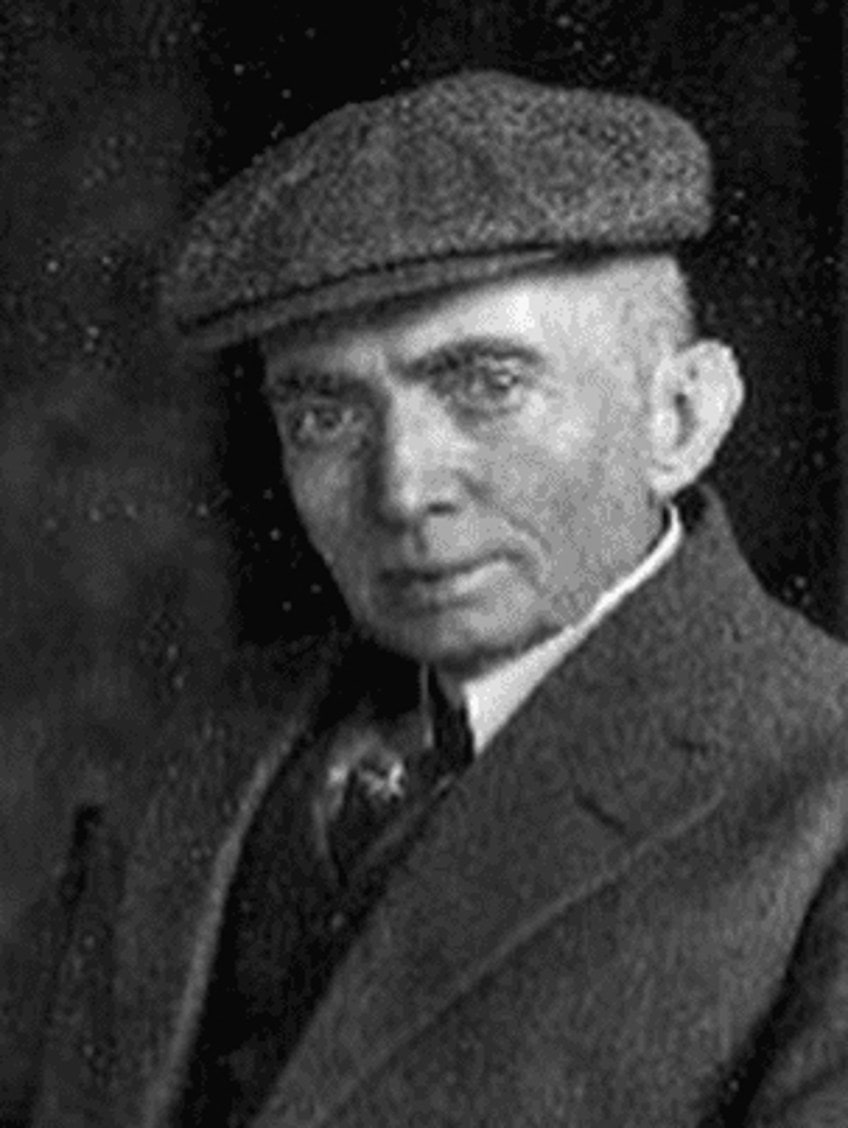
A Friend In Need By Cassius Marcellus Coolidge In Context
Dogs Playing Poker is the collective name for a series of 18 paintings by the American artist Cassius Marcellus Coolidge, who often wrote his name as “Kash Koolidge”. In this article, we take a closer look at one of the more famous paintings from the series titled A Friend In Need (c. 1903 – 1910). Reportedly, this painting was not sold, but like several of Coolidge’s other paintings that sold for millions of dollars, it too is worth millions of dollars.
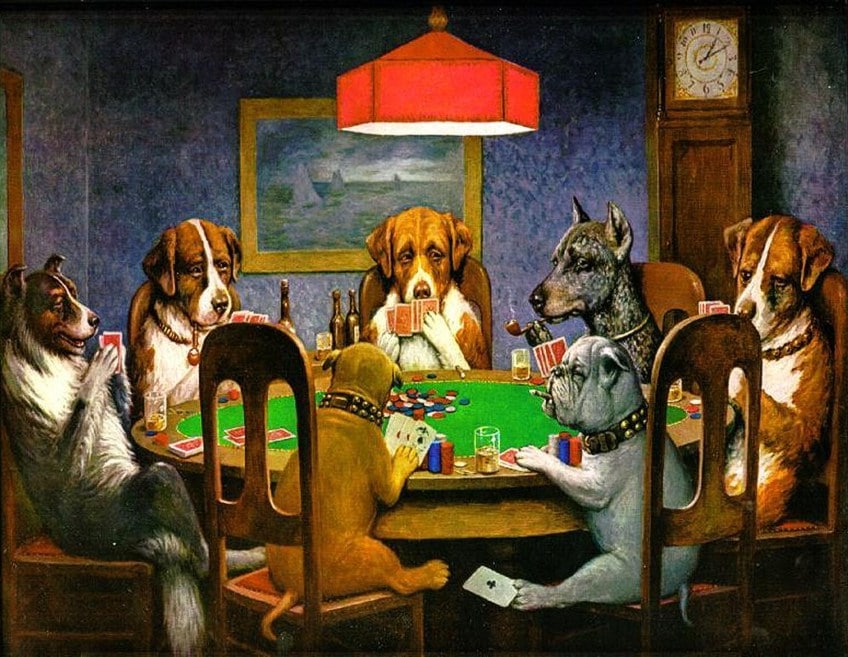
Below we will outline a brief contextual analysis of the Dogs Playing Poker series, including Coolidge’s first painting and how he developed the series further through a commission. We will then look at A Friend In Need in more detail, providing a formal analysis in terms of the subject matter and some stylistic elements like color and so forth. We will also discuss various ideas and influences that could have inspired Coolidge.
| Artist | Cassius Marcellus Coolidge |
| Date Painted | 1903 |
| Medium | Oil painting |
| Genre | Animal painting, Kitsch |
| Period / Movement | American art from the 20th century |
| Dimensions | Not available |
| Series / Versions | Part of the series of 18 paintings called Dogs Playing Poker |
| Where Is It Housed? | Not available |
| What It Is Worth | Never sold, but it is worth millions of dollars |
Contextual Analysis: A Brief Socio-Historical Overview
Cassius Marcellus Coolidge was not well-known, his art series Dogs Playing Poker have preceded his name and have become part of American pop culture. Although Coolidge did not train as an artist, he loved art and started painting in his twenties. The type of work he did also relate to painting; he worked as a cartoonist at one point for a newspaper and apparently illustrated various children’s books.
Coolidge was remembered as having a “playful” art style, he was also known as the inventor of the “comic foregrounds”, which are regular additions to any carnival or festivity.
This is where there is a hole in a piece of – usually – wood and a person can put their head through it while their body becomes whatever is painted on the wood in front of them. Sometimes it would be a funny character or a fantasy-like character, either way, these are fun and enjoyable, something Coolidge undoubtedly created in his artistic career.
The Beginnings of Dogs Playing Poker
As mentioned, the Dogs Playing Poker painting collection or series consist of 18 paintings, and it is important not to confuse it as one painting. Coolidge painted his first in the series titled Poker Game in 1894 and reportedly this painting was reproduced by various cigar companies who showcased it on their products, which also made their products stand out.
In 1903 the publishing company Brown & Bigelow, from Minnesota, United States, commissioned Coolidge to paint 16 of the Dogs Playing Poker painting series. The 16 paintings were similar to Coolidge’s first Poker Game (1894), which was not part of their commissions. Coolidge painted for Brown & Bigelow from 1903 until around the 1910s.

Brown & Bigelow reproduced the 16 paintings as images for promotional items that range from calendars, promoting cigars, posters, prints, and more. It is also worth noting that in 1910 there was an additional painting made titled Looks Like Four of a Kind, however, this was reportedly not a commissioned work.
Only nine paintings depicted dogs playing cards around a table and other paintings depicted dogs in various settings.
We see these “anthropomorphized” or “humanized” dogs playing baseball in One to Tie, Two to Win (c. 1903 – 1910) and football in Higher Education (c.1903 – 1910); some are a bit more sophisticated as we see in New Year’s Eve in Dogsville (c. 1903 – 1910) where there is a group of dogs dancing with one another in a beautiful ballroom.
Others are performing in front of royal canines in Riding the Goat (c. 1903 – 1910), which has been described as a Masonic initiation; then we see other dogs traveling, trying to fix their car in Ten Miles To A Garage (c. 1903 – 1910), and a Bulldog and Boston Terrier pleading in a “Promise to Marry” court case in Breach of Promise Suit (c. 1909 – 1910).

The other paintings all depict scenes of dogs playing cards or engaging in a card game activity, often smoking cigars, and drinking; some are also shown playing pool, for example in Kelly Pool (c. 1903 – 1910), others are playing cards while camping, seen in Stranger in Camp (c. 1903 – 1910) and then there is A Bachelor’s Dog (c. 1903 – 1910) depicting a dog leisurely lounging in an armchair, a cigar in his mouth, and a newspaper on his lap.
Below is a comprehensive list, in alphabetical order, of all the paintings from the Dogs Playing Poker series. The dates range from 1903 until the 1910s.
| Title |
| The Poker Game (1894) |
| A Bachelor’s Dog |
| A Bold Bluff |
| A Waterloo |
| A Friend In Need |
| The Reunion |
| His Station and Four Aces |
| New Year’s Eve In Dogsville |
| One To Tie, Two To Win |
| Pinched With Four Aces |
| Poker Sympathy |
| Post Mortem |
| Riding the Goat |
| Sitting Up With a Sick Friend |
| Stranger In Camp |
| Ten Miles To a Garage |
| Breach of Promise Suit (c. 1909 – 1910) |
| Looks Like Four of a Kind (1910) |
What Inspired Coolidge to Paint Dogs Playing Poker?
Various sources suggest that Coolidge could have been inspired by several Classical and Modern artists due to the similarities in his subject matter compared to that of painters like Michelangelo Merisi da Caravaggio, who was an Italian Baroque painter, the French Baroque painter Georges de La Tour, and the Post-Impressionist Paul Cézanne.
All the above-mentioned artists reportedly also depicted the theme of card games in their paintings.
For example, we will see this from Caravaggio’s painting The Cardsharps (1594), which depicts two boys playing cards and a man helping one of the boys to cheat. In De La Tour’s painting The Card Sharp with the Ace of Diamonds (1636 to 1638), we also see several men and women around a table, and the gentleman on the right is also being cheated in his card game. Similarly, in Cézanne’s painting The Card Players (1890 to 1892), which is one of a series of others, he depicts three men playing at a table and a fourth man standing against the wall in the background.

With the above-mentioned examples, it is not certain that these exact paintings were inspirations for Coolidge, but they give us a helpful visual reference when we view the Dogs Playing Poker paintings. The only difference is that Coolidge replaced the humans with dogs.
There have also been comparisons between Coolidge’s A Friend In Need and Sir Edwin Landseer, who was an English painter, and his artwork Laying Down the Law (1840). In his artwork we see a large white French Poodle dog sitting on a red couch with his paw on a book, suggestive of being the judge while the other surroundings dogs could be lawyers.
Many also suggest that this is a more serious painting compared to Coolidge’s painting.
Dogs Playing Poker Meanings
There are other meanings surrounding why Coolidge painted the Dog Playing Poker series, which also hints at his satirism. The authors, Martin J. Smith and Patrick J. Kiger, suggest that Coolidge was “mocking” the upper class. Their book, Poplorica: A Popular History of the Fads, Mavericks, Inventions, and Lore that Shaped Modern America (2004) includes the propositions that Coolidge’s painting pointed to how the upper class acted as well as lived among their riches.

There have also been other meanings regarding Freemasonry; Coolidge was in fact part of the Masonic Lodge in Antwerp where he was born. It has been suggested that the artist included Masonic references that would only be understood by other members. This is evident in his painting Riding the Goat.
There are various motifs in Riding the Goat that indicates the Masonic initiation that involves riding a goat, furthermore, the blindfolds, rope around the St. Bernard’s neck, the costume worn by the dog in the forefront, and other symbols all indicate what are part of the Masonic circles and ceremonial initiations.
Coolidge Pups: The Stars of Pop Culture
Or should we say, “Pup Culture”? The Coolidge pups have become stars in 20th-century pop culture and, as we mentioned earlier, their allure has seemingly succeeded that of the artist himself. They have made appearances in television series, films, theatre, television ads, card games, music album covers, video games, as well as books.
Some examples of where we can find Coolidge’s pups include several episodes from the famous television series The Simpsons, namely, Tree House of Horror IV (Season 5), Two Dozen & One Greyhounds (Season 6), Day of Wine and D’Oh’ses (Season 11), and The Mansion Family (Season 11).
Other series and their episodes include Law & Order’s “American Jihad” (Episode 1, season 13), That 70s Show’s “Hunting”, Lilo & Stitch: The Series, “Finder” (2003), Family Guy’s “Saving Private Brian” and “Road to Rhode Island”, among many others. The pups have appeared in films like Hudson Hawk (1991), Looney Tunes: Back In Action (2003), Around the World in 80 Days (2004), Up (2009), and The Accountant (2016).
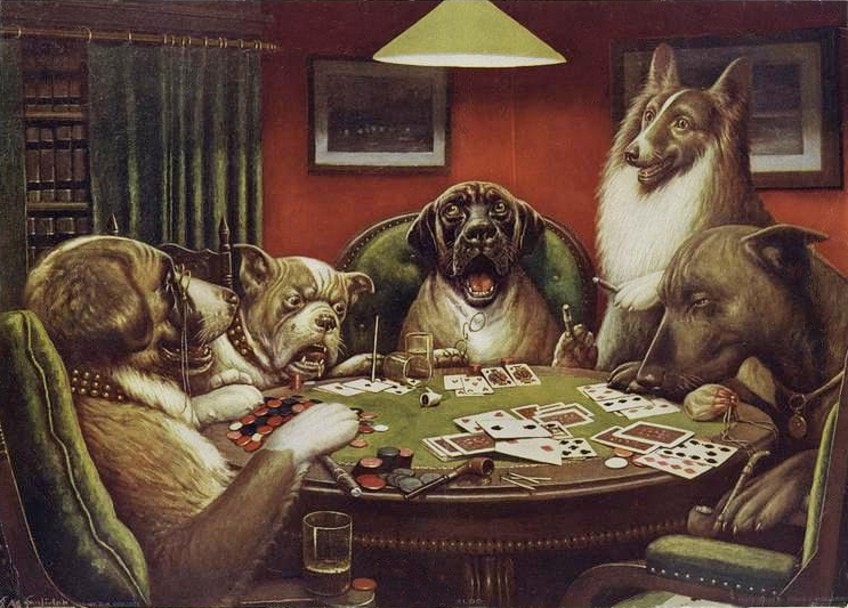
In music, the famous dogs have also been alluded to on the famous rap star, Snoop Dogg’s album I Wanna Thank Me (2019). The album cover depicts a similar setting as the painting A Friend In Need, but only humans and not dogs. Snoop Dogg also featured the Coolidge dogs in his earlier music video for his song, What’s My Name? (1993).
In the video game Psychonauts (2005) the dogs playing cards are also depicted as well as spoken about by characters who say, “Aren’t we all just dogs playing poker?”. Other games include the fantasy card game Magic: The Gathering (2004) in their “Arena league” where one card called “Mise” depicts dogs around a table, but this time they appear to be playing magic cards.
The dogs playing cards have been featured in more television series and films not mentioned here.
They have become not only promotional images for cigars or calendars but humorful cameos. They have also featured in the television adverts for the ESPN Sunday Night Football (1998 and 1999).
“Koolidge” And Kitsch: What Critics Have Said
Regarding Dogs Playing Poker Cassius Marcellus Coolidge received considerable critique about his art and whether his series was in fact art or just “Kitsch”, which is an art style Dogs Playing Poker has been categorized in. The idea of Kitsch started during the late 1800s in Germany, Munich, reportedly in various art markets where art was sold for lesser prices. It has been viewed as “low art” compared to “high art”.
Furthermore, Kitsch is associated with commodity-like items that appeal to the masses.
This includes reproduced items like decorative ornaments, souvenirs, keepsakes, and undoubtedly what would have been various items whereon Dogs Playing Poker could have been placed and consumed by the public, for example, calendars or cigars.
Below, we mention a few of the widely referred to examples of how the Dogs Playing Poker series have been described by others – not only in the field of art but other fields like Poker. In the online-based Poker News, their article Poker and Pop Culture: Dogs Playing Poker, the author mentioned that Dogs Playing Poker paintings have been described as enjoying their “iconic status in American popular culture”.
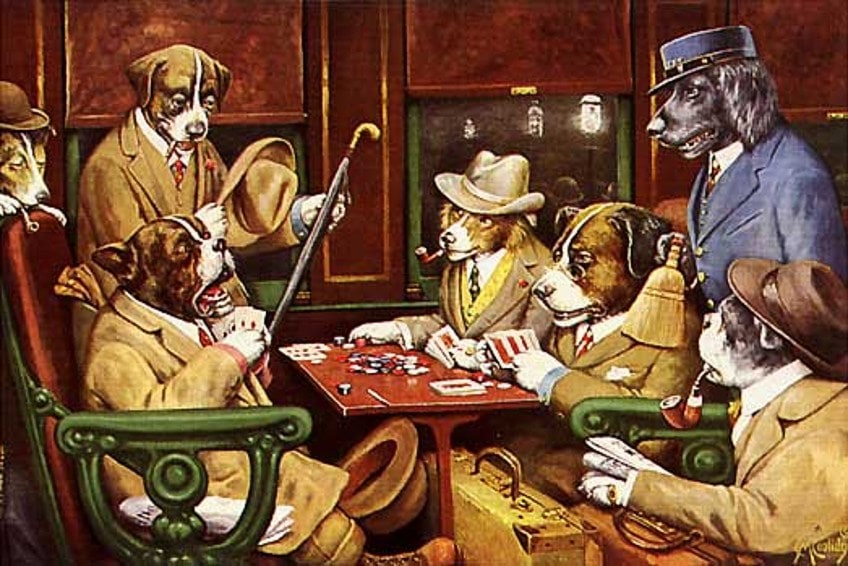
He further stated, “for some, the paintings represent the epitome of kitsch or lowbrow culture, a poor-taste parody of “genuine” art. For others they stand as cogent, insightful symbols of America’s middle class”.
Other prominent art institutions like the Chrysler Museum of Art in Norfolk, Virginia, United States, played an April Fool’s Day prank by writing in a press release that they desired to obtain the Dogs Playing Poker paintings for an exhibition. At the bottom, there was an Editor’s note that stated, “April Fool! Every word printed above is true with the single exception of the suggestion that the Chrysler is actually trying to obtain these paintings”.
The director of the Chrysler Museum, William Hennessey wrote the above prank, but he was also reportedly remembered as stating at a later stage that he did like the paintings.
Coolidge’s wife and daughter were reportedly cat people, and his daughter, Gertrude Marcella Coolidge has been widely quoted from her 2002 interview in the New York Times, in this interview she stated, “You can’t imagine a cat playing poker”.
Formal Analysis: A Brief Compositional Overview
Below we take a closer look at just what these pups are up to by discussing Coolidge’s painting, A Friend In Need (1903). This painting has been known as one of the more famous paintings from the Dogs Playing Poker series because of its “casual mood” as some sources describe. It is also reportedly the most reproduced.
Subject Matter
In A Friend In Need, we see seven dogs sitting around a round poker table, each seemingly engrossed in their deck of cards, waiting for the winner who might just be the golden-furred dog with his back to us in the foreground; he is holding what appears to be three Ace cards and being handed, slyly, the fourth by the Bulldog to his right.
The Bulldog to the right is a white-furred, and he hands, or paws, the fourth Ace card with his left back leg where the rest of the dogs cannot see; his left front leg is resting on his set of cards on the tabletop. He has a cigar in his mouth.
Coolidge is capturing the moment in time as the white Bulldog hands the sly Ace to his friend, however, his friend has not yet taken hold of this card and it leaves the narrative open and us wondering what the outcome will be of this card game.
If we move clockwise from the two central figures in the foreground to the left, we see a black-and-white-furred dog leisurely sitting, holding his set of cards in both his paws, he appears to be looking at his cards.
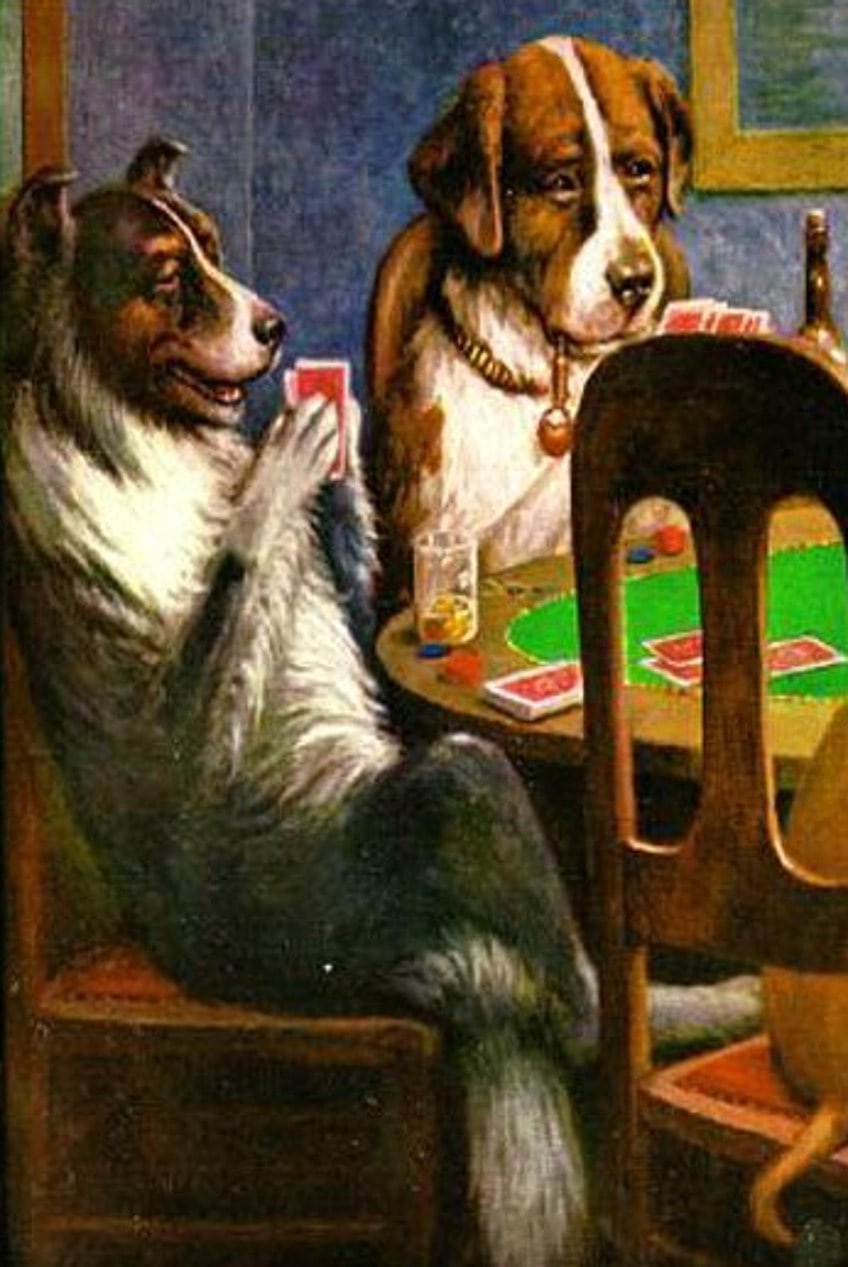
Next to this dog is what appears to be a St. Bernard with a pipe on the right side (our left) of his mouth. He is holding up and looking at his set of cards while seemingly glancing to his left (our right). Similarly, next to him is another dog in the same position, holding up his cards. Although, his cards cover up his mouth area making it unclear if he is smoking a cigar or pipe. His eyes seem to be gazing to his left (our right).
Next, with short blackish fur, is the fourth dog from the golden-furred dog with the set of Aces. He sports a pipe in his mouth and holds it with what looks to be his right paw while his left is holding his set of cards. His eyes are also seemingly gazing to his left. Is he aware or suspect of what is happening under the table? Next to him is another light-brown and white-furred dog that appears engrossed in his set of cards and slightly disengaged from the rest of the group; his head is tilting towards the left.
This brings us to the main culprit, the Bulldog handing the fourth Ace card to his friend, indeed, he is “a friend in need” in this painting. This is also what the main narrative of the painting is about.
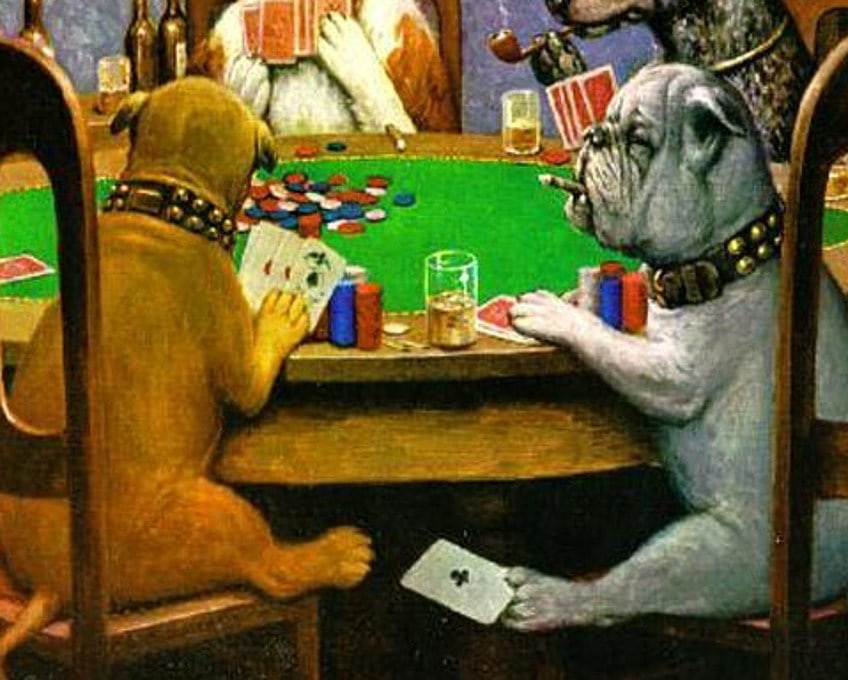
If we look at the surroundings of the painting, we see the dogs are in a room or lounge. There is a red-shaded cuboid-shaped lamp on the ceiling above, lighting up the central area on the green poker table. To the right corner of the room, against the wall, is a tall Grandfather clock showing the time 01:10 AM.
This also indicates to us that the dogs are playing their poker game at late hours of the evening and that this game has probably been going on for a few hours already.
On the wall directly opposite the viewer’s gaze, there is a painting of what appears to be a seascape with a few boats; the wall to the left also has a painting, but we can only see part of its wooden frame. The walls are painted in blue purplish color.
There appears to be another table against the wall in the background with three bottles on it and a glass of spirits, possibly Whiskey or Brandy. We see more glasses, filled to a third, on the poker table by each dog, indicating the dogs are enjoying their poker game, smoking their cigars and pipes, and drinking their drinks.
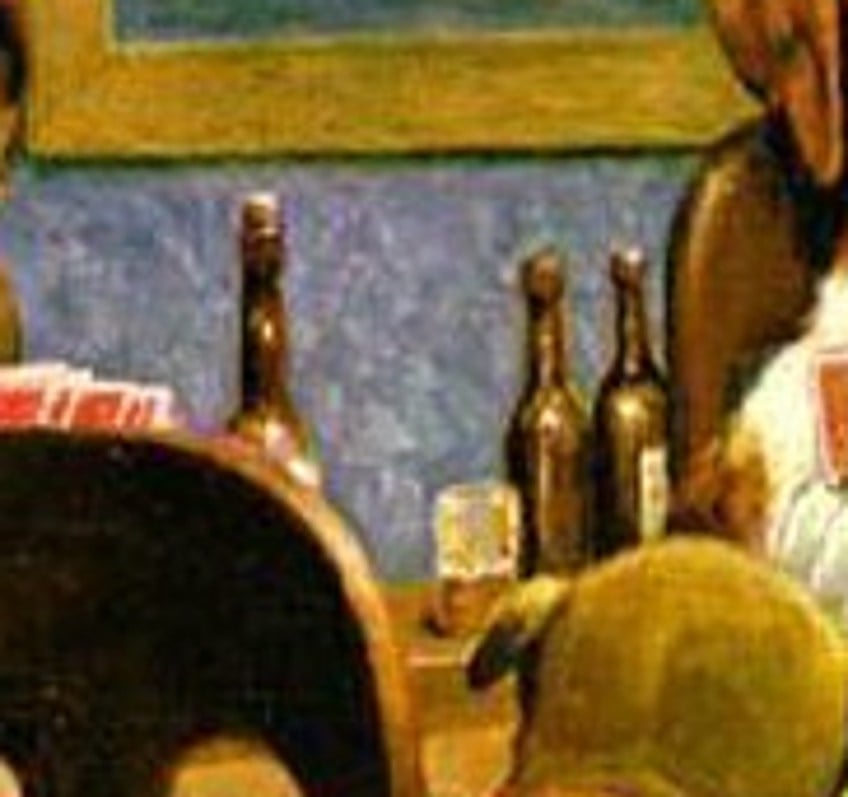
This has often been suggested as a highly relatable painting, especially for those who love to get together with friends and play a game of cards. Generally, A Friend In Need depicts this overall sense of leisure and good times with friends. This can also be applied to non-poker games like watching a sports game or having a movie night.
The more we look at the painting the more we notice small details in the dogs’ composure, and we start to question whether the dogs are leisurely enjoying themselves as well as being highly suspicious of one another.
This is evident when looking at their eyes, some seem to be gazing at others while others are not, but this is also questionable. This makes the painting more enjoyable and simultaneously quite humorous.
Color and Light
The colors Coolidge used in this painting are browns, reds, and mostly earthy colors that all give a cozy effect when we look at the composition. He created a sense of light that spreads over the poker table and the central composition highlighting the card game. Dogs Playing Poker by Cassius Marcellus Coolidge is painted with oils on canvas.
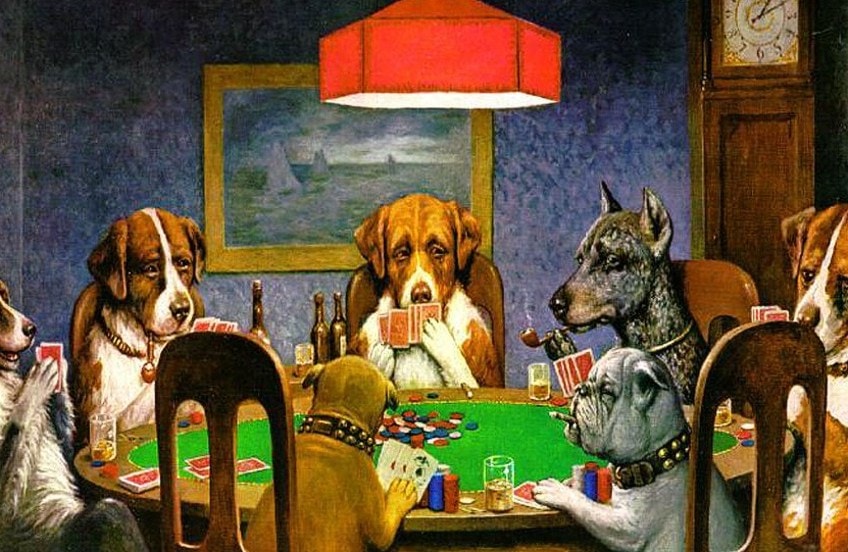
Perspective
A Friend In Need is depicted from an eye-level perspective where we are made to feel like we are viewing the scene from not too far away. This is also like many of the other Dogs Playing Poker paintings, except for one that shows more of an aerial angle and action in the background, in One To Tie, Two To Win, nonetheless, he still places a dog right in the forefront making us part of what the dog is experiencing.
Coolidge always seems to place us close to the dogs and the narrative, which makes the paintings more intimate and engaging.
Kash Koolidge: “Who Let the Dogs Out?”
However Coolidge’s paintings have been received by the art world, oftentimes as not serious at all and more “lowbrow” art than anything else, nonetheless, these dogs playing cards paintings have been well received by the world at large. They have jumped off their platforms as promotional imagery for calendars and cigars and found their way all over popular culture today.
It is safe to say that “Kash Koolidge” has let all his dogs loose on the world and that they have become the adored animals we endearingly chuckle at today. Maybe by making us chuckle, Coolidge has achieved his purpose in art, which was to entertain and keep things light-hearted, making his art career a wide, and wild, success. Coolidge’s obituary read, “He painted many pictures of dogs”.
Take a look at our Dogs Playing Poker webstory here!
Frequently Asked Questions
Who Painted Dogs Playing Poker?
Dogs Playing Poker was painted by the American painter Cassius Marcellus Coolidge. He was also known by a nickname as “Kash Koolidge”.
Is Dogs Playing Poker a Series?
Dogs Playing Poker is a series of 18 oil paintings of dogs engaging in human activities, mostly of dogs playing poker. The first painting from this series was created in 1894, titled Poker Game and then 16 were commissioned by the Brown & Bigelow company, and in 1910 Coolidge created another painting, which totals 18 paintings.
Isabella studied at the University of Cape Town in South Africa and graduated with a Bachelor of Arts majoring in English Literature & Language and Psychology. Throughout her undergraduate years, she took Art History as an additional subject and absolutely loved it. Building on from her art history knowledge that began in high school, art has always been a particular area of fascination for her. From learning about artworks previously unknown to her, or sharpening her existing understanding of specific works, the ability to continue learning within this interesting sphere excites her greatly.
Her focal points of interest in art history encompass profiling specific artists and art movements, as it is these areas where she is able to really dig deep into the rich narrative of the art world. Additionally, she particularly enjoys exploring the different artistic styles of the 20th century, as well as the important impact that female artists have had on the development of art history.
Learn more about Isabella Meyer and the Art in Context Team.
Cite this Article
Isabella, Meyer, “Dogs Playing Poker Cassius Marcellus Coolidge – An Analysis.” Art in Context. November 24, 2021. URL: https://artincontext.org/dogs-playing-poker-cassius-marcellus-coolidge/
Meyer, I. (2021, 24 November). Dogs Playing Poker Cassius Marcellus Coolidge – An Analysis. Art in Context. https://artincontext.org/dogs-playing-poker-cassius-marcellus-coolidge/
Meyer, Isabella. “Dogs Playing Poker Cassius Marcellus Coolidge – An Analysis.” Art in Context, November 24, 2021. https://artincontext.org/dogs-playing-poker-cassius-marcellus-coolidge/.






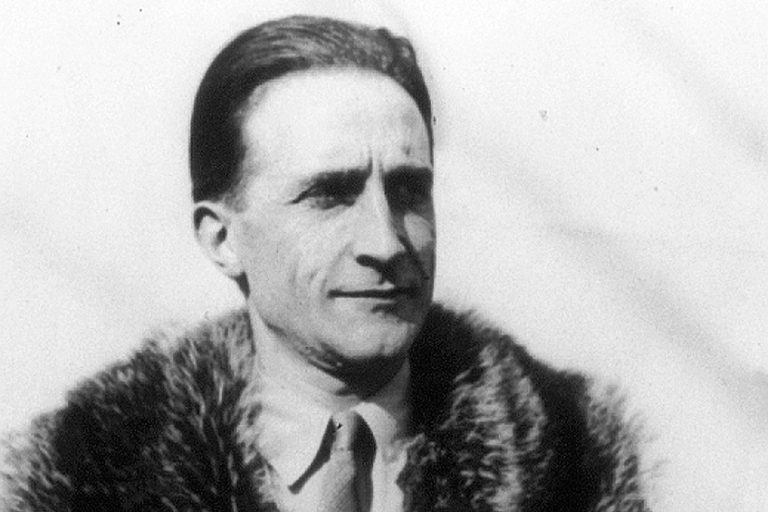

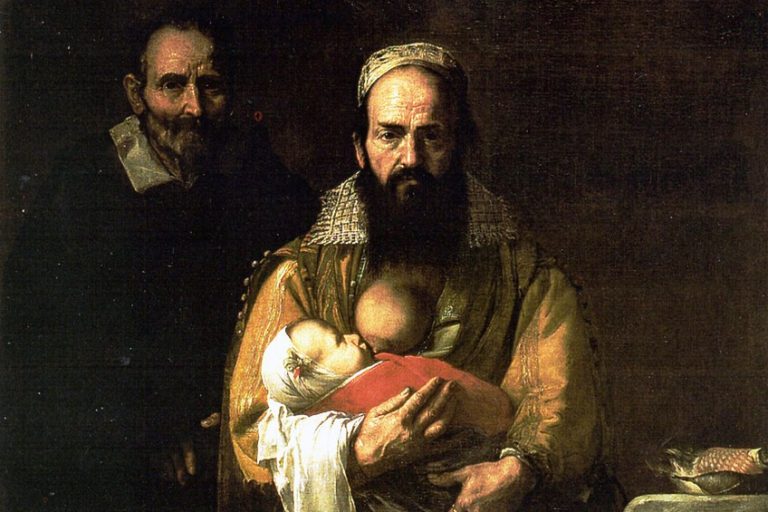
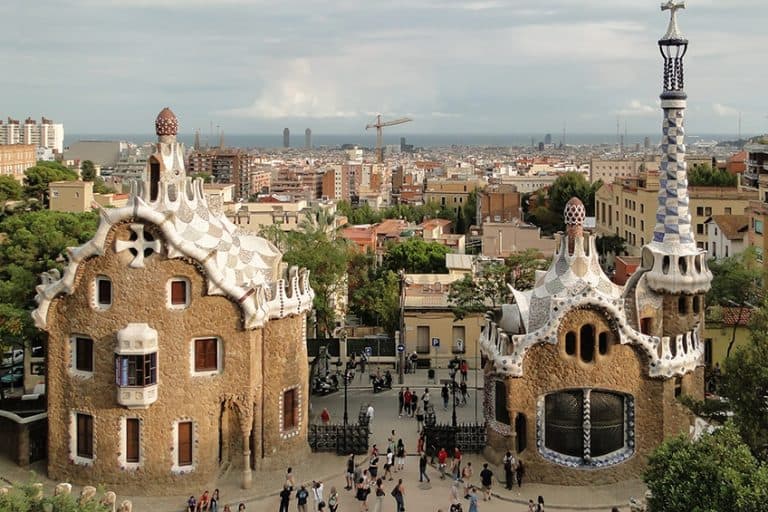


Greetings,
I have inherited two very old prints from Cassius Coolidge’s Dogs Paying Poker series. I am wondering if you can advise if there are characteristics to determine their age and potential value.
Thank you.